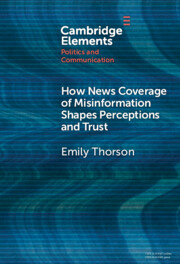Element contents
How News Coverage of Misinformation Shapes Perceptions and Trust
Published online by Cambridge University Press: 28 May 2024
Summary
- Type
- Element
- Information
- Online ISBN: 9781009488815Publisher: Cambridge University PressPrint publication: 20 June 2024



